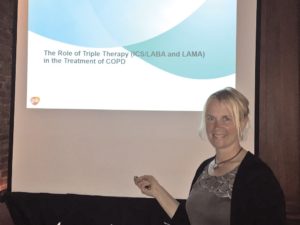A breath of fresh air
Medical scientist Laura Shostak ’91 tackles COPD, asthma
 Laura Shostak ’91 hopes to help patients breathe a little easier.
Laura Shostak ’91 hopes to help patients breathe a little easier.
A medical scientist at GlaxoSmithKline, she focuses on improving the quality of life for patients with chronic obstructive pulmonary disease (COPD)—a group of lung diseases that block airflow and make it difficult to breathe—and asthma. COPD is the third leading cause of death in the U.S.
In her role, she works with investigators involved with clinical trials; delivers educational lectures to various health care providers; attends international scientific symposia; and provides medical support for sales representatives.
“It is a unique position I honestly had never heard about until I applied for it in 2000,” she said.
Her position entails engaging with external experts in the field of pulmonology and allergy to stay abreast of the latest research.
“I gather and learn about their medical opinions, issues, questions and any medical and scientific needs of these experts as it relates to their patients. We make sure health care providers that are treating patients have the most current information they need to make appropriate decisions for their patients,” she said.
Shostak, a biology major at Wheaton, always had an interest in the sciences. But she also wanted to experience the benefits of a well-rounded liberal arts education, she said.
“Subjects that caught my attention outside of my major included French, which I continued from high school, and also a world religion class, which was extremely thought-provoking,” she said.
In the sciences, three particular classes and professors that left an impression include chordate anatomy, taught by Professor John Kricher, Professor Betsey Dyer’s genetics class and Professor Edmund Tong’s physiology class.
“The dedication and compassion that these professors bestowed on their students was very contagious and it definitely helped me confirm my interest in science,” she said.
Following graduation, Shostak considered various professions in the sciences, getting her feet wet in an array of disciplines before deciding to pursue hands-on research.
“The mechanisms of how medications work to target disease always held my interest,” she said, adding that this interest led her to pursue a Ph.D. in pharmacology at the University of Vermont. She received her Ph.D. in 1997.
In her current role, one large area of focus is medication adherence. This entails educating health care providers about the importance of patients adhering to their appropriate and prescribed medication regimens.
“I’m always encouraging those who treat patients to share success stories with me about how our medicines helped patients breathe better, stay out of the hospital longer or stories about patients who now have a more favorable quality of life that they so deserve,” she said.